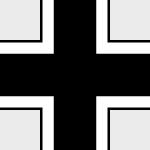Corgi AA32518 German Junkers Ju-87B-2 Stuka Dive-Bomber - J9+BL, 9./Sturzkampfgeschwader 1, St. Pol, France, November 1940 (1:72 Scale)
"Only he is lost who gives himself up for lost!"
- Hans-Ulrich Rudel, Stuka Pilot
 The Junkers Ju 87 or Stuka (from Sturzkampfflugzeug, "dive bomber") was a two-seat (pilot and rear gunner) German ground-attack aircraft. Designed by Hermann Pohlmann, the Stuka first flew in 1935 and made its combat debut in 1936 as part of the Luftwaffe's Condor Legion during the Spanish Civil War.
The Junkers Ju 87 or Stuka (from Sturzkampfflugzeug, "dive bomber") was a two-seat (pilot and rear gunner) German ground-attack aircraft. Designed by Hermann Pohlmann, the Stuka first flew in 1935 and made its combat debut in 1936 as part of the Luftwaffe's Condor Legion during the Spanish Civil War.
The aircraft was easily recognizable by its inverted gull wings, fixed spatted undercarriage and its infamous
Jericho-Trompete ("Jericho Trumpet") wailing siren, becoming the propaganda symbol of German air power and the "Blitzkrieg" victories of 1939-1942. The Stuka's design included several innovative features, including automatic pull-up dive brakes under both wings to ensure that the plane recovered from its attack dive even if the pilot blacked out from the high acceleration. Although sturdy, accurate, and very effective, the Ju 87 was vulnerable to modern fighter aircraft, like many other dive bombers of the war. Its flaws became apparent during the Battle of Britain; poor manoeuvrability, lack of speed and defensive armament meant that the Stuka required a fighter escort to operate effectively.
The Stuka operated with further success after the Battle of Britain, and its potency as a precision ground-attack aircraft became valuable to German forces in the Balkans Campaign, the African and Mediterranean Theaters and the early stages of the Eastern Front campaigns where Allied fighter resistance was disorganized and in short supply. Once the Luftwaffe had lost air superiority on all fronts, the Ju 87 once again became an easy target for enemy fighter aircraft. In spite of this, because there was no better replacement, the type continued to be produced until 1944. By the end of the conflict, the Stuka had been largely replaced by ground-attack versions of the Focke-Wulf Fw 190, but was still in use until the last days of the war. An estimated 6,500 Ju 87s of all versions were built between 1936 and August 1944.
This particular 1:72 scale replica of a German Junkers Ju-87B-2 Stuka dive-bomber was attached to 9./Sturzkampfgeschwader 1, then deployed to St. Pol, France, during November 1940.
Sold Out!
Dimensions:
Wingspan: 7-1/2-inches
Length: 6-1/4-inches
Release Date: January 2020
 Historical Account: "Dirty Bombs" - Describing the Junkers Ju 87 Stuka as one of the most famous aircraft of WWII would certainly be accurate, although it could be argued that the word infamous would be more appropriate - the Stuka was without doubt, one of the most terrifying weapons from the early years of the Second World War. Taking a huge toll on Allied shipping, armored vehicles and general military and civilian infrastructure, the Stuka was a close air support and strike attack aircraft, capable of providing precision bombing support to advancing Wehrmacht ground units. Destroying strategically important targets before they could become a problem, these aircraft were feared more than any other weapon during the opening months of the Second World War, with the sight (and sound) of approaching Stukas usually signifying that devastation was heading your way.
Historical Account: "Dirty Bombs" - Describing the Junkers Ju 87 Stuka as one of the most famous aircraft of WWII would certainly be accurate, although it could be argued that the word infamous would be more appropriate - the Stuka was without doubt, one of the most terrifying weapons from the early years of the Second World War. Taking a huge toll on Allied shipping, armored vehicles and general military and civilian infrastructure, the Stuka was a close air support and strike attack aircraft, capable of providing precision bombing support to advancing Wehrmacht ground units. Destroying strategically important targets before they could become a problem, these aircraft were feared more than any other weapon during the opening months of the Second World War, with the sight (and sound) of approaching Stukas usually signifying that devastation was heading your way.
During the Battle of Britain, the RAF exposed the deficiencies of the Stuka in combat and they took a heavy toll of these much vaunted dive bombers. Losses became so severe that Stuka operations over England were restricted to night raids against coastal targets in the South East during the winter of 1940, with these aircraft being specially prepared for nocturnal operations. With the light blue under-surfaces completely over-painted with a black wash, all national insignia and most unit markings were also blacked out, in an attempt to make the aircraft less vulnerable to night detection by Britain's defenses.


